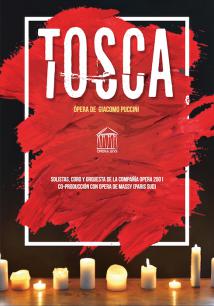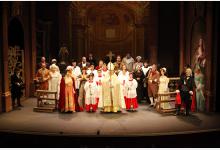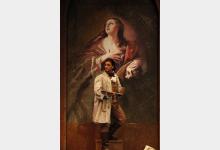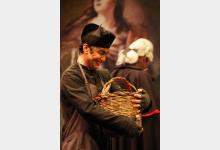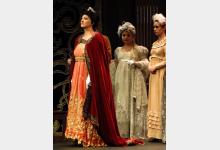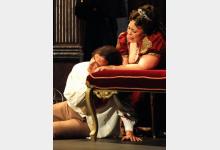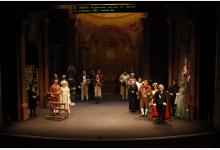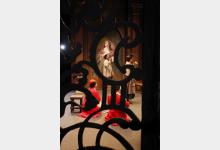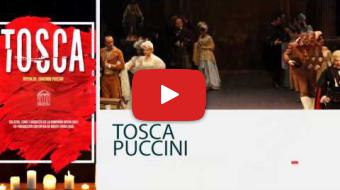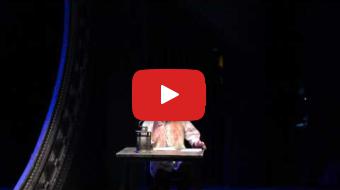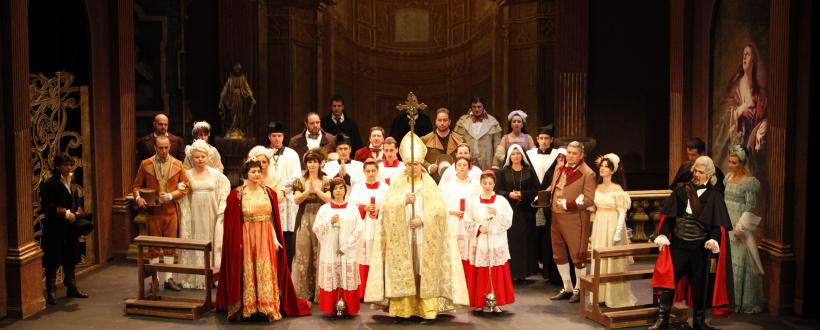
Tosca
Opera in three acts by Giacomo Puccini
Libretto in Italian by Luigi Illica and Giuseppe Giacosa
Based on the work by Victorien Sardou “La Tosca”
Original version in Italian with subtitles (optional)
Cast
Conductor : Martin MÁZIK, Dominique ROUITS
Stage Manager : Roberta MATTELLI
Artistic Director : Luis Miguel LAINZ
Stage designer : Alfredo TROISI
Scenographic Lab and Atrezzo: Tecnoscena (Naples)
Costumes : Sartoria Arrigo (Milán – Italia)
Shoes : Calzature di Epoca (Milán – Italia)
Wigs : Mario Audello (Turín – Italia)
TOSCA
Melanie MOUSSAY, Michelle FRANCIS COOK, Chrystelle DI MARCO
CAVARADOSSI
David BAÑOS, Eduardo SANDOVAL, Javier PALACIOS
SCARPIA
Giulio BOSCHETTI, Paolo RUGGIERO, Julien VERONESE
ANGELOTTI
August METODIEV
SACRISTAN
Matteo Peirone, Giancarlo TOSI
SCIARRONE
Nikolay BACHEV
SPOLETTA
Dimiter DIMITROV
* Cast still to be determined, this list is merely a guide based on our latest production. Auditions in progress to determine the final cast
Play's presentation
After the first evening a not really defined success with LA BOHEME, on February 1, 1896, this opera won astonishing fast the ear and the heart of half of Europe and other parts of the world. The worldwide success of Puccini that began in 1893 with Manon Lescaut had a brilliant takeoff. On November 24, 1887 TOSCA had premiered in Paris: A new drama by Victorien Sardou, one of the most famous authors of French theatre plays of that era with bright theatrical flair. Sardo wrote this role to be embodied by the greatest dramatic actress of France: Sarah BERNHARD. Puccini saw the drama in 1889, in Milan, and despite his poor knowledge of the French language, he was fascinated. The great actress with her gestures and the diversity of her features fully expressed the intrigue of the play and was able to captivate only through the visible drama and thanks to her great skill even without understanding a single word. He left the theatre seduced and rushes to telegraph RICORDI, his editor: "I will put music to Tosca. I beg you to immediately take the necessary steps to obtain SARDOU ‘s authorization... ". But SARDOU does not want to hear about his drama turning into an opera and rejects the proposition. TOSCA is forgotten.
Some years later another Italian composer, Alberto Franchetti, gets permission from SARDOU and starts writing music for TOSCA. The interest of PUCCINI is reborn for the dramatic story of the Roman singer from the Napoleonic era. The popularity of Puccini far excels that of his opponent and without much difficulty he recovers the script. Then begins the long process of rewriting the text. PUCCINI has the collaboration of librettist Luigi Illica and the prominent poet Guiseppe GIACOSA. The author is left to believe that his word carries weight. RICORDI acts as mediator. PUCCINI intervenes constantly demanding changes, cuts, additions. He meets several times with SARDOU for major changes: "Prodigious man. He is nearly 70 years old and is more full of vigor and agility than a young man. He is a tireless talker with a conversation which quickly becomes a monologue ... He ended up giving everything he was asked ... " SARDOU is excited about the way how ILLICA and GIACOSA make the adaptation of his TOSCA. The combination of the names of PUCCINI and SARDOU promises a worldwide success. The draft script of TOSCA is finished in late 1896, but it is only in 1898, on his return to Italy, when Puccini puts with all his energy to the composition of the new opera and on August 18 he concludes the first act. On July 16, 1899 PUCCINI ends the second act and the third on September 29, which is the conclusion of the opera TOSCA.
On October 14, 1900 TOSCA’s premiere is held at the Theatre Constanzi in ROME. It is rumoured that a device will explode during the performance. The political situation makes this possibility credible. The alarm ends up evacuating the theatre. Finally everything is back to order and the play is performed. It is a great success; as it will be around the whole world.
Synopsis
ACT I
Sant'Andrea della Valle church
Angelotti, ex-consul of the Roman Republic, has escaped from prison and taken refuge in the church.
His sister, the Marquise Attavanti, had sent him a message saying that at the family chapel he could find clothes to dress as a woman and flee to Rome. Angelotti looking for the key opens the chapel and hides inside. The Sacristan appears thinking to have heard footsteps, but he only finds the food basket of painter Mario Cavaradossi. The Angelus sounds, and then the painter arrives to continue his work with the picture.
The Sacristan recognizes in the portrait of Mary Magdalene a blonde lady who was praying in the church. But the painter only thinks about his beloved - Floria Tosca - an actress and singer of smoldering black eyes.
Angelotti, believing that is alone, leaves his hiding place but Cavaradossi sees him and after recognizing him, is willing to help him escape. The voice of Tosca is heard, Cavaradossi offers his your meal to the fugitive who hides again.
Tosca arrives and convinced of having heard voices and strange noises, makes a scene of jealousy. Noticing the resemblance of the portrait of Magdalene with Attavanti, her suspicions increase.
Finally she accepts that her jealousy torments Cavaradossi and decides to leave, calmly. Angelotti reappears and Cavaradossi offers his cottage, where he usually meets with Tosca, as refuge until he can leave the country. The cannon of the Castel Sant'Angelo is heard: Angelotti escape has been discovered. Cavaradossi decides to accompany Angelotti home.
The Sacristan enters, jubilant, to tell the painter the news that Bonaparte has been defeated.
The choir of the chapel arrive, there will be Te Deum of thanksgiving and they will get paid double. But their joy is cut short when the police chief Scarpia arrives with his henchmen to search the Attavanti chapel and they find the crest from Attavanti and the empty basket. Scarpia deduces that Angelotti has been aided in his escape.
Tosca reappears looking forward to seeing Cavaradossi, and Scarpia insinuates that the painter has left with the lady of the picture. Tosca, jealous, decides to surprise them in the cottage. Scarpia sends Spoletta to follow her and to stop Angelotti if he finds him there. Meanwhile, Scarpia plans not only to capture Angelotti but also to seduce Tosca. Te Deum begins and everyone joins the general prayer.
ACT II
Farnese Palace. Offices of Scarpia.
Sitting in his office at the Farnese Palace, Scarpia reflects on the search for Angelotti and about his amorous desires. The echo of the party given the Queen in honor of the victory is heard. Scarpia orders for Tosca to be brought to his presence, after she finishes her performance before the queen. Spoletta, scared, brings news that Angelotti has not been found, but he is saved from the wrath of Scarpia when he announces that they have been captured Cavaradossi. Scarpia interrogates Cavaradossi, but seeing that good manners are unsuccessful, orders one of his minions to begin torturing him to confess. In the middle of the torture Tosca arrives, who listening to the screams of her beloved Cavaradossi gives in and confesses to Scarpia where Angelotti is hidden, making the torture stop. But when Cavaradossi realizes that his torture has ceased thanks to Tosca's confession, he accuses her of being a traitor. Sciarrone arrives to convey Scarpia grave news:
Napoleon has won the Battle of Marengo and absolutist troops have taken flight. Cavaradossi, unable to contain his joy, exclaims his faith in the approaching end of tyranny.
Scarpia can not condone such behavior and orders that the prisoner is prepared to be immediately executed. Scarpia and Tosca are left alone. The police chief offers to Tosca the possibility to save the life of her beloved painter if in return she gives in to his amorous desires. Tosca attempts to flee, but in her disorientation she does not know where to go.
Her tears and pleas have no effect at all and she is forced to give in: she will be his, but first she requires a pass for her and her lover to flee Rome.
Scarpia pretends to give the necessary orders to Spoletta so that the execution of Cavaradossi is only simulated, adding cryptically: "As we did with Count Palmieri". Spoletta, who knows very well that Palmieri was executed, leaves, and Scarpia, impatient, wants to jump inmediately on his victim, but before Tosca demands a safe-conduct. While Scarpia writes, Tosca seizes a sharp knife. Scarpia's fate is sealed: Tosca takes the opportunity to stab him in the chest, grab the pass and she leaves after placing two lighted candles next to the head of the corpse of his mortal enemy and a crucifix on his chest.
ACT III
Upper terrace at Sant'Angelo’s Castel
It is dawn. The song of a shepherd and the bells of the churches of Rome can be heard. A platoon brings Cavaradossi in. The jailer browses through papers, and finds the name of the offender and announces him that he still has one hour to live. In exchange for a ring he gets permission to write a few words to a loved one. While writing, full of nostalgia, he poures hot tears that cannot wrest the atrocious torments. Tosca walks in, rushes to Cavaradossi, shows him the safe-conduct and tells him what happened, that the execution will be simulated and he has to act natural when they pretend to shoot him. The platoon shoots against the prisoner. Mario falls without a sound. Once alone Tosca approaches Cavaradossi, calls him, trying to lift him, but it is all in vain: Mario is dead.
From below sound voices of horror: Scarpia's body has been discovered and Spoletta with the help of Sciarrone appears to arrest Tosca. But Tosca is not willing to get caught. She quickly climbs the castle wall and dominated by a sudden decision, jumps into the void.

